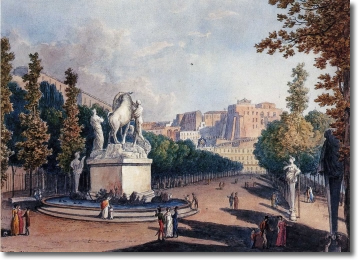
The evolution of the green areas of Naples is linked to the historical events that characterized the city and the surrounding territory. The natural characteristics of places acquire a new shape and a new sense following the human settlement. In the Neapolitan area, it is possible to appreciate only from the Middle Age thepresence of the hortus conclusus, or in other words the garden disconnected from the traditional agricultural function.The hortus conclusus is a garden with many tree species, it is surrounded by high walls, moreover it has a separate entrance.
Until the Renaissance and during the Baroque era, the garden is surrounded by walls and divided into multiple sectors.
From 1734 to 1799, the Indipendent Bourbon monarchy ruled Naples. Charles became of Ferdinand IV in 1759. It was duringthis period that new landscapes were created and a new concept of the relationship between the urban and the rural scene was introduced. King Charles was aware of the value of parks in terms of prestige and economic stimulus, for this reason he decided to build the Capodimonte Hood (1734) and the Royal Palace of Caserta (1752).
These new projects represented a new ideal of the urban development, opposed to the idea of the messy development of the previous centuries.
The extensive program that leads to the creation of the new sites is inspired by a changed view of the relationship between the city and its surroundings. The proximity of the city to large forest reserves, lakes and wetlands that are home to a large and varied fauna, gives rise to the formation of a system of areas reserved for hunting for the King and his court; they are places that will take the name of the actualsites, such as Astroni crater, Agnano basin, Licola coast, Cardito and Carditello, Fusaro lake and Capodimonte.
Another important event is the construction of the Public Garden - Villa Comunale in Chiaia in 1780. the Palace was born as a "royal walk" for the nobility. The Villa was open to the public in 1860 and the first public garden was inaugurated. In the nineteenth century, the characteristics of a new model of settlement, as the one of the villa, are defined. The nobility moved overthe hills and in places much celebrated by painters. During the 20th century, because of the increase in population, the city expanded into new areas such as Vomero and Fuorigrotta. During the Fascist period the Virgiliano Park was established.
Nowadays,urban parks and gardens play a significant role in the city, indeed they promote the connection between people and nature and the psico-perceptive wellness. After the earthquake of 1980, the design choices of the urban plans changed since new areas are going to be created in order to reestablish the balance between the population and the territory. The new policies of rehabilitation and defense of the green adopted by the Town Council also leadto the recovery of many degraded areas, through the Safeguard Plan and theOrdinance No. 1243 of 29.06.2005 on the protection of the trees. The new urban system that needs to be continually enhanced to meet the large demand of the community.